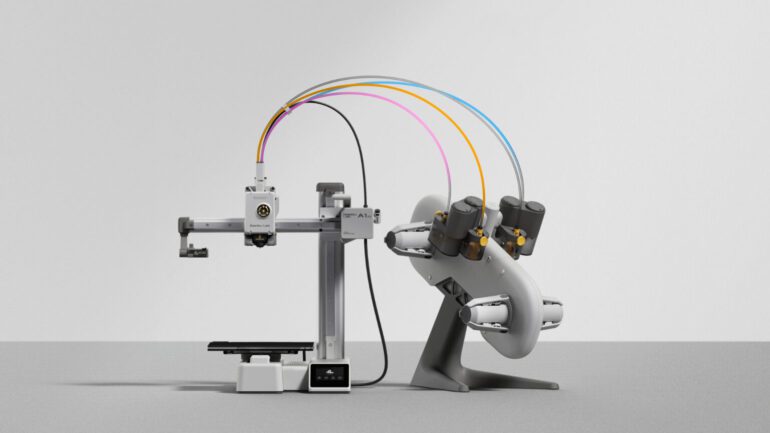TL;DR:
- Bambu Lab launches AI Mini, a feature-packed 3D printer with multi-filament capabilities.
- The AI Mini offers auto-calibration, noise cancellation, and seamless cloud integration.
- Bambu Lab’s aggressive pricing strategy aims to dominate the 3D printing market.
- Challenges include component issues and reliance on cloud services.
- Bambu Lab’s innovations are poised to accelerate the entire 3D printing industry.
Main AI News:
Bambu Lab has emerged as a transformative force within the desktop 3D printing community, redefining industry standards through innovation and affordability. Their holistic approach, encompassing advanced software integration, rigorous testing, and vibration reduction technology, has culminated in the creation of an exceptionally rapid, feature-rich 3D printer at an unparalleled price point. Bambu Lab’s foray into the market has not only sparked a wave of ambition among competitors but has also opened doors to a new era of feature-packed, high-performance 3D printing experiences.
Despite the groundbreaking strides made by Bambu Lab, there persists a degree of skepticism regarding the true impact of their 3D printers. Many are left questioning the source of the excitement surrounding the brand. To clarify matters, the 3D printing realm was hitherto characterized by incremental hardware enhancements and value engineering. However, Bambu Lab has demonstrated that a harmonious fusion of cutting-edge software and sophisticated hardware can democratize superior desktop 3D printing for a broader audience. This revelation has ignited a fervor for heightened performance and enhanced user experiences across the industry. Although the long-term reliability of Bambu Lab’s offerings remains under scrutiny, one fact is undeniable—Bambu Lab has reshaped the competitive landscape for all.
The AI Mini: Crafting a New Paradigm
Now, the company introduces its latest innovation, the AI Mini, poised to make yet another indelible mark on the 3D printing landscape. At first glance, the AI Mini exudes the amalgamation of a Printrbot and a Monoprice Select, characterized by a refined design aesthetic. What sets it apart is the Automatic Material System (AMS), which facilitates four-color filament 3D printing. With an impressive 18 by 18 by 18 cm build volume, the AI Mini arrives pre-calibrated, boasting an active noise cancellation motor—an ideal choice for seamless desktop operation. Straight out of the box, this printer is primed for action, equipped with automated calibration functions that encompass Z-offset, bed leveling, and even “X & Y axis vibration resonance.”
Augmenting its sophistication, the AI Mini is replete with an array of sensors dedicated to managing and regulating material flow. For user convenience, it incorporates a user-friendly touchscreen interface and seamless integration with Bambu’s MakerWorld Thingiverse/Management tool and Bambu Studio.
While the company appears to be exploring offline capabilities, this device leans predominantly toward cloud-tethered functionality. Bambu Lab perceives this as a strength, affording them control over the user experience and data collection. However, this reliance on cloud-based infrastructure could potentially become a vulnerability if users hesitate to embrace it or harbor reservations towards Bambu Labs for any reason. Notably, the device maintains consistent connectivity for data gathering, a pivotal aspect for optimizing settings and performance. This, however, raises privacy concerns for some. Access to comprehensive settings, complete 3D print data, and sensor feedback positions the company favorably, enabling tailored optimizations for each print job and scenario.
Equipped with an RFID sensor for filament identification, the printer remains adaptable to other filament options. The all-metal chassis features precision linear bearings with encased screw rods for durability. The printer’s capability to measure filament speed, presence, and motion allows it to mitigate feeding issues effectively, thereby enhancing output through flow rate adjustments. Furthermore, ambient temperature sensors fine-tune settings, significantly influencing print quality for discerning users. Active noise cancellation operates on both the X and Y axes, and the printer boasts an impressive top speed of 500mm/s, with peak acceleration pegged at 10,000 mm/s^2. Additionally, it offers a quick-swap hot end for added convenience.
In terms of pricing, the AMS Light unit is attractively priced at $249, while the A1 Mini is competitively positioned at $299. A bundled offering of both units stands at a compelling $459. Given these remarkable features and pricing, the AI Mini emerges as an exceptionally well-equipped and cost-effective 3D printer. Pending rigorous testing and performance assessments, if the printer upholds the repeatability and reliability of its predecessors, it is poised to make an indomitable impact in the 3D printing arena.
Bambu’s Ambitious Pursuit of Market Dominance
One cannot help but wonder how Bambu Lab sustains profitability with such aggressive pricing strategies. Evidently, Bambu Lab’s vision extends far beyond the sale of individual 3D printers; it aspires to assert dominance across the entire market spectrum. The scale of their ambition is nothing short of monumental. If this launch unfolds as planned, Bambu Lab will secure a substantial advantage over its competitors. While the X1 system, priced between $1,200 and $1,500, already stood as a formidable contender due to its comprehensive feature set and top-tier output quality, the introduction of the P1S and P1P models, priced in the $600 to $800 range, signaled a strategic shift towards more accessible options. With the arrival of the Mini, the company is now targeting the lowest-priced 3D printers available.
Conclusion:
Bambu Lab’s AI Mini 3D Printer, with its affordable pricing and advanced features, is set to disrupt the market by offering an accessible yet sophisticated 3D printing experience. While challenges and critics persist, Bambu Lab’s relentless pursuit of market dominance and innovation indicates a shift towards more accessible options, challenging competitors to keep pace and redefine industry standards.

